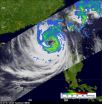(Press-News.org)
VIDEO:
The Swift observatory can rapidly rotate 50 degrees in less than 75 seconds to quickly observe the afterglow from a gamma ray burst (GRB).
Click here for more information.
Astronomers in Japan, using an X-ray detector on the International Space Station, and at Penn State University, using NASA's Swift space observatory, are announcing the discovery of an object newly emitting X-rays, which previously had been hidden inside our Milky Way galaxy in the constellation Centaurus.
The object -- a binary system -- was revealed recently when an instrument on the International Space Station named MAXI (Monitor of All-Sky X-ray Image) on the Exposed Facility of the Japanese Experiment Module "Kibo" caught it in the act of erupting with a massive blast of X-rays known as an X-ray nova. The MAXI mission team quickly alerted astronomers worldwide to the discovery of the new X-ray source at 2:00 a.m. EDT on 20 October, and NASA's Swift Observatory quickly conducted an urgent "target-of-opportunity" observation nine hours later, which allowed for the location of the X-ray nova to be measured accurately.
"The collaboration between the MAXI and Swift teams allowed us to quickly and accurately identify this new object," said Jamie Kennea, the Swift X-ray Telescope instrument scientist at Penn State University who is leading the Swift analysis. "MAXI and Swift's abilities are uniquely complementary, and in this case have provided a discovery that would not have been possible without combining the knowledge obtained from both."
The Swift detection confirmed the presence of the previously unknown bright X-ray source, which was named MAXI J1409-619. "The Swift observation suggests that this source is probably a neutron star or a black hole with a massive companion star located at a distance of a few tens of thousands of light years from Earth in the Milky Way," said David Burrows, professor of astronomy and astrophysics at Penn State and the lead scientist for Swift's X-ray Telescope. "The contribution of Swift's X-ray Telescope to this discovery is that it can swing into position rapidly to focus on a particular point in the sky and it can image the sky with high sensitivity and high spatial resolution."
"MAXI has demonstrated its capability to discover X-ray novae at great distances," said Kazutaka Yamaoka, assistant professor at Aoyama Gakuin University and a member of the MAXI team. "The MAXI team is planning further coordinated observations with NASA satellites to reveal the identity of this source."
INFORMATION:
IMAGES
High-resolution images associated with this research are online at http://www.science.psu.edu/news-and-events/2010-news/Nousek10-2010
SCIENCE CONTACTS:
David Burrows, professor of astronomy and astrophysics at Penn State and the lead scientist for Swift's X-ray Telescope: (+1) 814 865-7707, burrows@astro.psu.edu
Jamie Kennea, Swift X-ray Telescope instrument scientist at Penn State: (+1) 814-865-0234, kennea@astro.psu.edu
Neil Gehrels, Chief of the Astroparticle Physics Laboratory and Swift principal investigator at NASA's Goddard Space Flight Center: (+1) 301-286-6546, gehrels@gsfc.nasa.gov
P.I.O. CONTACTS:
Barbara K. Kennedy (Penn State PIO): 814-863-4682, science@psu.edu
Lynn Cominsky (Swift PIO): 707-664-2655, lynnc@universe.sonoma.edu
MORE ABOUT THE SWIFT OBSERVATORY: The Swift observatory was launched in November 2004 and was fully operational by January 2005. Swift carries three main instruments: the Burst Alert Telescope, the X-ray Telescope, and the Ultraviolet/Optical Telescope. Its science and science and flight operations are controlled by Penn State from the Mission Operations Center in State College, Pennsylvania. Swift's gamma-ray detector, the Burst Alert Telescope, provides the rapid initial location and was built primarily by the NASA Goddard Space Flight Center in Greenbelt, Maryland, and Los Alamos National Laboratory in New Mexico and constructed at GSFC. Swift's X-Ray Telescope and UV/Optical Telescope were developed and built by international teams led by Penn State and drew heavily on each institution's experience with previous space missions. The X-ray Telescope resulted from Penn State's collaboration with the University of Leicester in the United Kingdom and the Brera Astronomical Observatory in Italy. The Ultraviolet/Optical Telescope resulted from Penn State's collaboration with the Mullard Space Science Laboratory of the University College-London. These three telescopes give Swift the ability to do almost immediate follow-up observations of most gamma-ray bursts because Swift can rotate so quickly to point toward the source of the gamma-ray signal. The spacecraft was built by a company then called General Dynamics, which now is called Orbital Sciences Corporation.
MORE ABOUT THE MAXI TEAM: The MAXI team, a Japanese collaboration of JAXA, RIKEN, Osaka University, Tokyo Institute of Technology, Aoyama Gakuin University, Nihon University, Kyoto University, Miyazaki University, and Chuo University, is collaborating with the international Swift Team, led by Neil Gehrels at NASA's Goddard Space Flight Ceneter, as well as with the Japanese X-ray satellite Suzaku.
Space telescopes reveal previously unknown brilliant X-ray explosion in our Milky Way galaxy
2010-10-23
ELSE PRESS RELEASES FROM THIS DATE:
LSUHSC study IDs proteins regulating water retention in salt-sensitive hypertension
2010-10-23
New Orleans, LA – Research conducted by scientists at LSU Health Sciences Center New Orleans has found that two proteins in the brain act as valves to turn the hormone that regulates water retention in the body on and off. Their findings may lead to advances in treatment for diseases like high blood pressure, congestive heart failure, and cirrhosis of the liver. The research is published in the November 1, 2010 issue of Endocrinology.
Daniel Kapusta, PhD, Professor of Pharmacology at LSU Health Sciences Center New Orleans, and Richard Wainford, PhD, LSUHSC Instructor ...
Making school lunchrooms smarter
2010-10-23
Saratoga Springs, NY: Don't ban it, move it. This is one conclusion of a new Cornell University study. In one set of schools, sales of fruit increased by 100% when it was moved to a colorful bowl. Salad bar sales tripled when the cart was placed in front of cash registers.
These findings presented today at the School Nutrition Association's New York conference, underscore the easiest way to lunchroom choices is to make an apple more convenient, cool, and visible than a cookie. The conclusion of six different studies with over 11,000 middle and high school studies ...
Green Carbon Center takes all-inclusive view of energy
2010-10-23
Rice University has created a Green Carbon Center to bring the benefits offered by oil, gas, coal, wind, solar, geothermal, biomass and other energy sources together in a way that will not only help ensure the world's energy future but also provide a means to recycle carbon dioxide into useful products.
Whether or not one believes in anthropogenic climate change, the fact is humans are throwing away a potentially valuable resource with every ton of carbon dioxide released into the atmosphere, said James Tour, Rice's T.T. and W.F. Chao Chair in Chemistry as well as a professor ...
Mount Sinai researchers discover origin of immune cells in the brain
2010-10-23
Mount Sinai researchers have discovered that microglia, the immune cells that reside in the brain, have a unique origin and are formed shortly after conception. It was previously thought that microglia originated at the same time as macrophages, which are other immune cells that are thought to develop at birth. This groundbreaking discovery has the potential to lead to future treatments of degenerative brain diseases such as Alzheimer's and autoimmune diseases such as multiple sclerosis. The study is published online October 21 in Science Express.
Microglia are thought ...
UC San Diego researchers identify factor boosting leukemia's aggressiveness
2010-10-23
Chronic lymphocytic leukemia (CLL) cells survive and thrive not just by their own innate wiles, but by also acquiring aid and support from host cells in their surrounding environment. In a paper published online this week in The Proceedings of National Academy of Sciences, an international team of researchers led by cancer specialists at the University of California San Diego School of Medicine and the Moores UCSD Cancer Center identify a particular relationship that can promote notably aggressive leukemias and lymphomas.
"The microenvironment is the term used to describe ...
Practice-changing studies on how oncologists treat cancer to be presented at ASTRO Annual Meeting
2010-10-23
The following are highlights of new cancer research being released at the American Society for Radiation Oncology's (ASTRO) 52nd Annual Meeting to be held October 31 through November 4, 2010, in San Diego.
For full copies of the abstracts and press releases, contact Nicole Napoli at nicolen@astro.org or Beth Bukata at bethb@astro.org. Studies are embargoed until October 25, 2010, at 1:00 p.m. Eastern time.
Adding radiation to hormone therapy for prostate cancer treatment will increase survival chances
Prostate cancer patients who are treated with a combination of hormone ...
UH engineering professors featured in consecutive issues of Science
2010-10-23
HOUSTON, Oct. 22, 2010 – Researchers can spend entire careers producing outstanding work but still not see their efforts featured in the pages of Science, one of the world's most prestigious scientific journals. That won't be the case, though, for two junior faculty members in engineering at the University of Houston (UH).
Jacinta Conrad and Jeff Rimer, both assistant professors in Cullen College of Engineering's department of chemical and biomolecular engineering, had papers featured in consecutive issues of Science this month.
"Jacinta and Jeff are both extremely ...
From obscurity to prime time: Viral political videos can spring from non-political sites
2010-10-23
What's the mechanism that makes a political video go viral? What causes a video clip to spread from a few people to millions, sometimes in a matter of hours? Is it a top-down process led by elite gatekeepers or bottoms up, driven by people at the grass roots? And how do blogs affect the life cycle of a viral video?
Common wisdom might suggest that a posse of political blogs triggers virality, but research from the University of Washington indicates it often springs from just two elite blogs followed by top general interest outlets that aren't considered political.
A ...
Falling in love 'more scientific than you think,' according to Syracuse University professor
2010-10-23
A new meta-analysis study, "The Neuroimaging of Love," conducted by Syracuse University Professor Stephanie Ortigue, reveals that falling in love can elicit not only the same euphoric feeling as using cocaine, but also affects intellectual areas of the brain. Researchers also found falling in love only takes about a fifth of a second.
Ortigue is an assistant professor of psychology and an adjunct assistant professor of neurology, both in The College of Arts and Sciences at Syracuse University.
Results from Ortigue's team revealed when a person falls in love, 12 areas ...
NASA satellites see Typhoon Megi poised for southeastern China landfall
2010-10-23
Typhoon Megi has run into winds that are weakening the storm, but it is forecast to make landfall in southeastern China late at night (EDT) on Oct. 22 (11 a.m. local time Hong Kong, Oct. 23) as a Category One Typhoon. NASA satellites have been monitoring the storm's rainfall, changing cloud cover, and changing eye as it weakens.
The Tropical Rainfall Measuring Mission (TRMM) satellite traveled directly above Megi on October 21 at 1401 UTC (10:01 a.m. EDT) when wind speeds were estimated to be about 100 knots (~115 mph). Megi caused at least 27 deaths in the Philippines ...



